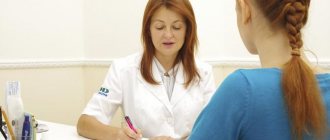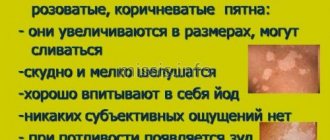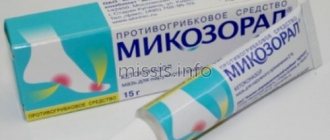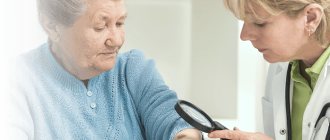- Initial appointment with a dermatologist
1200 ₽ - Calling a dermatologist to your home
4000 ₽
Pityriasis versicolor –
a recurrent disease that affects only the horny surface of the epidermis. The pathology is called “lichen versicolor” because the spots have colors: yellow, whitish, brown. The skin begins to peel off and spots appear in the summer in children and adults. Residents of countries with high humidity and warm climates are susceptible to pathology.
In Russia, skin formations appear in 15% of the population. These are mainly people from 15 to 40 years old, more often observed in men. Children under 7 years of age rarely get shingles. For treatment, contact a dermatologist at our clinic, he will conduct an examination and prescribe medications that will improve the patient’s condition.
Types of pityriasis versicolor:
- Spotty-flaky. During the period of spread, it affects the body in different places: behind the ears, in the groin areas.
- Erythematosquamous. Often observed in adults and children. The rash is beige or coffee-colored, without inflammation. At first the formations are small, but soon they increase in size. This type appears on the head. It worsens in autumn and spring.
- Follicular. Lesions appear on the legs, back, chest, and arms. The spots spread in the hair follicles, their size is up to 3 mm, and itching is observed. This form can form during antibacterial therapy or the use of steroids in people with diabetes.
- Inverted. Characterized by peeling, itching, redness. This species is not common. When the disease occurs, symptoms are not expressed; spots appear on the head.
If you experience formations on the skin, it is better to seek help from qualified specialists at our clinic. Quickly identifying the disease in its early stages will help prevent its spread.
Lichen planus
Lichen planus in humans is a chronic dermatosis that affects the skin in the form of small, itchy and often flaky nodules.
Etiology
The specific type of pathogen has not been identified. Refers to multifactorial diseases. Pathology can be caused by various provoking circumstances: mental shock, taking certain medications (for example, tetracycline), various irritating chemicals, diseases of the gastrointestinal tract.
Clinical picture
Elements of the rash are presented in the form of itchy nodules with a diameter of 1-3 mm, in the center of the surface there is an umbilical depression. The rest of the surface of the papule is shiny. The color of the formations ranges from crimson to bluish-red with a pearlescent tint. The nodules are covered with the so-called Wickham mesh - a fine mesh pattern characteristic only of lichen planus. Favorite places for lesions are: the flexor surfaces of the limbs, symmetrically on the sides of the body, lower back, and genital area. Much less often, rashes can appear on the head, palms, and feet. With a long course, Koebner's symptom is detected - new papules appear at the sites of microtraumas of the skin.
Diagnostics
With a typical picture of the disease, characteristic clinical external signs and localization of lesions are taken into account.
Treatment
They establish a connection between the disease and stress or past infections. Conduct diagnosis and treatment of concomitant pathologies.
- Local treatment of lichen: creams and ointments with glucocorticosteroids are applied to the lesions, antihistamines and B vitamins are taken orally.
- Phototherapy methods in the form of:
- PUVA therapy (local application of a photosensitizer to the lesions, followed by irradiation with long-wave UV rays).
- Selective light therapy (combination of long-wave and mid-wave UV radiation).
Traditional methods
Symptoms of pityriasis versicolor:
- Formation of pink spots. At first they are single, then they increase in size and merge. Rashes are observed on the stomach, neck, under the hair, on the chest.
- As the disease spreads, they become dark in color. May be red or brown. The colors vary on the affected areas, which is why lichen is called tinea versicolor. In some cases, the formations merge into one whole.
- After a certain time, peeling occurs. The scales resemble bran.
- Itching is observed, but not in all cases.
- After healing, white or light spots remain on the skin; tanning does not affect them; this is caused by cell damage as a result of fungi.
Scaly lichen (psoriasis).
Psoriasis (squamosal lichen in humans) refers to nodular-scaly non-contagious dermatoses. The cause of psoriasis has not yet been identified. However, its development is caused by immunogenetic failures. So scientists identified the psoriasis gene - PSORS1, as well as a special population of T-lymphocytes that cause inflammatory tissue damage. In psoriasis, there are disorders of fat metabolism, manifested by high levels of blood lipids and early development of atherosclerosis. In 30-60% of patients, exacerbations of psoriasis are caused by traumatic situations.
Clinical picture
Psoriasis rashes look like dense plaques of pink-red color. The surface peels off with silvery scales and is dry, which causes itching. When scratching the papules, the scales easily come off (symptom of stearin stain), after removing the scales the surface begins to shine (symptom of terminal film), if you scratch further, a few drops of blood will be released (symptom of “blood dew”).
These symptoms are combined into the “psoriatic triad,” a characteristic feature of psoriasis. The rashes are localized on the extensor surfaces of the extremities, lower back, sacral area, and scalp (psoriatic crown). Plaques can merge, and in advanced cases, warty growths form. The scales on their surface turn yellow, stick together, and purulent bacterial flora joins.
Diagnostics
- External examination, identification of the “psoriatic triad” characteristic of psoriasis.
- Biopsy diagnosis of skin (for psoriasis, a histological specimen reveals, along with inflammation, disturbances in keratinization processes).
- Blood test (confirmation of inflammation, diagnosis of hyperlipidemia).
Treatment
- Immunosuppressive therapy for severe psoriasis (cytostatics, glucocorticosteroids, retinoids).
- Prescription of drugs that improve the rheological properties of blood (trental, rheopolyglucin, hemodez, heparin and others).
- Detoxification therapy.
- Local therapy in the form of ointments, creams containing keratoplasty drugs and/or glucocorticosteroids.
- Phototherapy methods: PUVA therapy (local application of a photosensitizer to the lesion followed by irradiation with long-wave UV rays).
Selective light therapy (combination of long-wave and mid-wave UV radiation).
- Diet contributes to the clinical cure of psoriasis. The patient limits the consumption of nightshade vegetables and spices. Refuses smoking and drinking alcohol.
Traditional methods
Diagnosis of pityriasis versicolor
The disease is diagnosed by a dermatologist. He performs a visual examination of the patient, studies the presence of spots and their distribution, and makes a diagnosis at this stage. If the form of lichen is not pronounced, then the clinic specialist uses the following methods. Using a Wood's lamp, he makes several tests. After highlighting areas of the skin, they may change color to yellow-red or green.
To clarify the diagnosis, laboratory diagnostics will be required. Specialists using special equipment will be able to detect the presence of the disease after additional research.
What it is?
Pityriasis versicolor is a long-term (chronic) fungal infection of the stratum corneum of the epidermis. A common (slang) name that can be found at resorts is “solar fungus.” It is necessary to distinguish the disease from Vitiligo, pink zhibert and syphilitic roseola.
The name “lichen” (Lichen) has been known since the time of Hippocrates; it includes many skin diseases, which are characterized by the formation of colored spots and peeling. The causative agent of pityriasis versicolor was described by G. Robin in 1853, and in 1951 M. Gordon identified round and oval forms of the pathogen, both in places of pityriasis versicolor rashes and within healthy skin, classifying it as a yeast-like fungus.
Differential diagnosis of pityriasis versicolor with other diseases
To make a diagnosis, the doctor performs the following procedures:
- Conducting an examination under a microscope to determine the scraping. The specialist scrapes the scales from the skin area, processes it and examines it. Using a microscope, it is possible to detect spores and fungi that are round in shape. The mycelium threads are white in color and long in shape, like a thread.
- Balzer test. A 5% iodine solution is used, which is applied to or near the infected areas. This study will take time; the affected skin gradually acquires a different color.
How does a fungal infection occur?
It is possible to contract such an infection in several ways, including transmission from a person with confirmed mycosis, from animals, and extremely rarely from soil. The most common locations where you can become infected with fungus are places with high humidity, baths, saunas, and swimming pools. Particularly favorable environments for the life of fungus are wooden coverings, places of stagnation and accumulation of water.
The infection itself occurs due to pathogenic scales from the affected skin, which remain on the floor when people with a mycotic infection walk with their bare feet.
It is important to consider that you can become infected with a fungal infection in public places where fungal spores can get on the hands, face and other parts of the body of a healthy person, for example in a pedicure salon, on the beach, in hotels. Also, parents suffering from a mycotic infection can infect their own child through close contact and failure to comply with personal hygiene rules.
⠀
In children, a fungal infection develops quite quickly due to increased vascularization of children's skin, reduced bactericidal activity of the sweat and sebaceous glands, as well as due to the immaturity of the immune system. All this affects the reproduction and penetration of the fungus into the child’s epidermis.
Treatment of pityriasis versicolor
The dermatologist prescribes treatment depending on the nature and form of the disease, the characteristics of the lesion, the age of the patient, and the presence of other pathologies. Applies complex treatment, which includes ointments, sprays, creams, shampoos. They consist of components that effectively affect the disease. Depending on the complexity of the pathology, the patient is prescribed tablets. Therapy will help overcome lichen in a short time and eliminate complications.
For treatment, the doctor prescribes ointments that contain terbinafine. Treatment of the affected skin area is prescribed 2 times a day. This substance quickly destroys microbial cells and eliminates the appearance of new formations. Imidazole, clotrimazole and others are effective for treatment. The substances are included in creams and gels. Tolcyclate and ciclopirox are ointments prescribed to ensure that the pathogens quickly die.
When lichen appears in the hair, the doctor prescribes shampoos containing ketoconazole or nizoral. In the initial stages, patients are recommended salicylic and zinc ointments. The products quickly relieve itching. You should not use medications without consulting a specialist. Qualified doctors of our clinic, using modern equipment, will diagnose and prescribe a course of treatment.
A visit to a dermatologist is necessary 21 days after the prescribed treatment. The doctor will assess the patient’s condition, prescribe additional medications and preventive measures, these include physiotherapy and others.
How is lichen transmitted?
The main sources of the disease are street cats and dogs, or objects containing flakes of their skin affected by the pathogen - a zoonotic form. However, lichen can be transmitted from person to person - an anthroponotic form of transmission, as well as with the help of fungi living in the soil - a geophilic transmission route. Viruses, as a cause of deprivation, can remain in the body of humans and animals for a long time, and only when the child’s immunity decreases can they provoke a disease.
Ringworm is not always contagious. Thus, children's weeping eczema occurs due to infection of microcracks in the skin, dermatoses, or the presence of allergic reactivity in the child's parents. According to the observations of experts, allergic diseases of the mother (asthma, rhinitis or neurodermatitis) increase the likelihood of eczema in the child by 40%. And Zhiber's pityriasis rosea is often a consequence of ARVI and is not transmitted to other people.
The period of high risk of contracting lichen is spring-summer, since the child spends most of his time outdoors and in contact with other children.
Contagious (infectious) types of lichen are pink, ringworm and herpes zoster. They require mandatory isolation of the child to prevent the rapid spread of the disease.
Lichen planus and pityriasis versicolor, as well as psoriasis and weeping eczema are not transmitted.
Prevention of pityriasis versicolor
To reduce the disease, preventive measures play an important role. They include regular washing of skin areas, removal of sweat, sebaceous fat, and regular change of bedding and clothing. In hot weather, antifungal shampoos are an excellent method. They will eliminate the occurrence of relapses. The specialist prescribes products for regular hair washing. As a preventive measure, it will take 5 to 7 days to use the drugs. The skin should be wiped with salicylic alcohol every day.
It is better to wash things not with powders, but with soap, adding soda to the water. You can avoid deprivation; for this you need to strengthen your immune system, eat right, and take vitamins once a year. Experts recommend playing sports and taking walks in the fresh air for treatment. In case of illness, it is recommended to include vegetables, herbs, fermented milk products in food, and exclude spicy, sweet and smoked foods.
Gastrointestinal disorders can cause pityriasis versicolor, so you need to undergo a course of treatment.
How is a fungal skin infection diagnosed?
Diagnosis of mycotic infection in children is as follows:
- Anamnesis collection. At this stage, the doctor finds out whether anyone else in the family has similar rashes, whether there are pets, whether the child attends sports clubs, swimming pools, preschool institutions, etc.
- Examination of the skin using a Wood's lamp. The golden-yellow glow of the scales is detected in lichen versicolor, bright green in microsporia.
- Scraping of hair, epidermal scales, horny masses from the nail bed, followed by microscopy of the material. This allows you to detect mycelium, spores and confirm fungal infection in children.
Complication of pityriasis versicolor
The pathology affects the upper layer of the skin, but is often severe. It affects internal organs.
In case of severe itching, the patient scratches the severely damaged skin. All this causes discomfort and leads to inflammation, in addition to infectious pathology. Contact a specialist immediately. You can’t just start the disease and start solving the problem. A specialist will help and prescribe medications to improve the condition.
If the disease returns after all measures, we recommend that you undergo examination by our specialists.
What are the types of fungal skin infections?
- The group of keratomycosis is a disease characterized by damage to the upper layer of skin by a fungal infection. Keratomycosis can affect not only the arms, legs, body, face and scalp, but also hair and nails. The infectious process in this disease does not spread to the deep layers of the skin.
- Dermatophytosis is characterized by a pronounced inflammatory process and dysfunction of the skin.
- Candidiasis (skin infection by fungal infections caused by a yeast-like fungus of the genus Candida) develops on the surface of the skin, changing its pH and suppressing the activity of microorganisms beneficial to humans.
- Deep mycoses (with damage to internal organs). Symptoms of fungal diseases, as well as the severity of the process, depend on the specific pathogen, the location and area of the infectious lesion. This also influences the decision on how to treat the disease.
Pityriasis versicolor in children
The disease is not typical for children under 6 years of age. During this period, the skin has protection mechanisms that prevent the dermis from being exposed to moisture and high temperatures. However, if caring for the baby is not correct, parents lubricate the skin with oils: shea butter, cocoa, then this disrupts the functioning of the defense mechanisms. For this reason, the disease appears in preschool age.
In children during the prepubertal period, hormonal changes begin in the body. The skin is very sensitive to high humidity and exposure to the sun, like adults. Thanks to changes, fungi can provoke the appearance of disease.
Ringworm in children occurs with the same symptoms as in adults. The treatment is no different. If redness appears, it is advisable to immediately consult a doctor. The specialist will conduct an examination and prescribe a drug that is suitable for the child’s age. It is not recommended to use the products without the advice of a specialist, as this can lead to negative consequences.
Symptoms in humans
Typical symptoms of pityriasis versicolor in humans are (see photo):
- The appearance of pink spots with a yellowish color;
- A gradual change in their color to brown pigmentation, localized in typical places (primarily the décolleté area);
- Slight fine-plate peeling of rashes that appear on the skin;
- Intermittent itching of the spots, which is not very intense;
- The skin does not tan in the place where the rash is localized. This is explained by the functional inferiority of melanocytes - skin cells that produce pigment.
To determine if you actually have sunburn, visit a dermatologist. The doctor will check your skin with a lamp - the fungus has luminescent properties. If the skin glows pink or greenish-blue, a dermatologist will diagnose lichen.
In humans, the symptoms of pityriasis versicolor, in the form of itching and burning, are often not expressed. If the doctor suspects the presence of a fungal pathogen, he will send the patient for analysis of keratinized skin flakes.
Pityriasis versicolor during pregnancy
As a result of hormonal changes, the appearance of pathology is possible, but it does not harm the mother and fetus. The disease causes discomfort, but self-medication and folk remedies are unacceptable. If pathology appears, contact a dermatologist, he will choose treatment and, if necessary, prescribe diagnostics. Pregnant women are prescribed therapy for ringworm, taking into account the danger of the situation.
The doctor prescribes drugs that do not enter the bloodstream, does not prescribe anti-fungal tablets, they are toxic and harmful to the unborn child. Nizoral is prescribed; it is not recommended to use the medicine without a prescription.
Many dermatologists advise delaying the full course of treatment until after the baby is born. The fungus is not harmful to the fetus and will not affect its development. Oral medications are prohibited during breastfeeding, as they can pass into the milk and harm the baby's health.
Why should you contact our clinic?
Dermatologists of the highest category
Experienced dermatologists in Moscow. Experience of specialists from 15 years.
Modern equipment
Modern equipment from the world's best manufacturers.
Expert class equipment
Ultrasound is performed using expert-class equipment manufactured by General Electric, SONY, Mindray.
Tests and ultrasound on the day of treatment
Tests, x-rays, ultrasound with interpretation, dressings on the day of treatment in Moscow.
Consultations for adults and children
A network of dermatological clinics in Moscow. Clinics near the metro.
Experienced doctors
Our experienced doctors with over 15 years of experience. Candidates of Medical Sciences.
Causes of pityriasis versicolor
The content of the article
Pityriasis versicolor or versicolor is a fungal disease that affects human skin. Its causative agent is a yeast-like fungus that causes folliculitis and seborrheic dermatitis.
The appearance of lichen is caused by the fungus Malassezia furfur. Its spores are present on the skin of most people, but reproduction is activated under certain conditions. Solar lichen began to be called due to the fact that one of the factors leading to the development of the disease can be prolonged exposure to the sun.
The infection becomes more active in the heat, which is why pityriasis versicolor is called “solar”. The disease is common in southern countries, but it is also common in Russia.
Factors that increase the risk of developing pityriasis versicolor:
- A sharp change in hormonal levels - pregnancy, taking hormonal medications, etc.
- Prolonged stress, viral infection, tumors, tuberculosis, diabetes, HIV and other diseases that kill the immune system.
- Severe exhaustion, including as a result of dieting.
- Vitamin A deficiency.
- Treatment with cytostatics or glucocorticoids.
- Heavy sweating.
Pityriasis versicolor is contagious, so an infected person can infect others. Most often, the fungus spreads to children, because their bodies are weaker than those of adults.
How to treat fungal infections?
Treatment of mycoses consists of medicinal use:
- antiseptic solutions;
- antifungal pastes, emulsions, ointments, varnishes;
- combined ointments when a secondary infection occurs, i.e. if fungal and bacterial skin infections are observed at the same time;
- systemic antifungal drugs (in cases of reluctance to external therapy or in severe forms of infection).
Basically, mycoses develop in people suffering from somatic diseases, with reduced immunity and various pathologies. Therefore, in addition to observing personal hygiene rules, it is important to monitor your overall health, strengthen your immune system, maintain a balanced diet and lead an active lifestyle.










